Papers by Beatrice Pasciuta

Juristische Glossierungstechniken als Mittel rechtswissenschaftlicher Rationalisierungen
Abhandlungen zur rechtswissenschaftlichen Grundlagenforschung
Rechtstexte zu glossieren und zu kommentieren steht am Anfang der europäischen Rechtswissenschaft... more Rechtstexte zu glossieren und zu kommentieren steht am Anfang der europäischen Rechtswissenschaft. Wie die Beiträge dieses Bandes zeigen, wurde diese rechtswissenschaftliche Methode nicht nur in Form der Standardglossen zum römischen und kanonischen Recht entwickelt, sondern auch von Rechtspraktikern erfolgreich auf die neuen regionalen Gesetzbücher und einheimische Rechtssammlungen in ganz Europa angewendet. Selbst in der Universitätsstadt Bologna war nicht ausgemacht, dass sich ausgerechnet die Glosse des Accursius als ‚glossa ordinaria‘ zum römischen Recht durchsetzen würde. In diesem Band werden Glossen im europäischen Zuschnitt behandelt. Während die Formen der Glossen weithin dem Bologneser Modell entsprachen, unterschieden sich die Erkenntnisinteressen, der Argumentationsstil, aber auch die Adressaten sonstiger Glossen deutlich von Standardglossen nach Bologneser Vorbild. Die Autorinnen und Autoren reflektieren anhand der behandelten unterschiedlichen juristischen Glossen die...
Mori, turchi et altri infidili": corsari e guerra da corsa in Sicilia fra norme e dottrina
il saggio analizza la normazione sulla pirateria e sulla guerra da corsa, nel regno di Sicilia fr... more il saggio analizza la normazione sulla pirateria e sulla guerra da corsa, nel regno di Sicilia fra XV e XVII secol
Tra diritto e politica: Andrea da Isernia e la Lectura al Liber Augustalis
Aspetti e questioni multidisciplinari della democrazia paritaria: lo spazio pubblico e privato dall’antichità ai nostri giorni, 2023
According to Christian doctrine, the damnation of humanity is caused by Eve, and salvation is mad... more According to Christian doctrine, the damnation of humanity is caused by Eve, and salvation is made possible by Mary.
My idea is that on the basis of these two female figures, both impossible models, legal doctrine, especially canon law, which is firmly based on theological doctrine but also on the sources of Roman law, builds a framework of possibilities and, above all, prohibitions that justify the reduced legal capacity of women as such and allow for conspicuous exceptions.
Spousal power in the codes and nineteenth-century legal reflection - (Mutual?) rights and duties ... more Spousal power in the codes and nineteenth-century legal reflection - (Mutual?) rights and duties - The debate on coercive measures to protect the "conjugal home" - Marital incapacity - (In)equal spouses: separation in French and Bourbonic codification

Documenting Multiculturalism: coexistence, law and multiculturalism in the administrative and legal documents of Norman and Hohenstaufen Sicily, c.1060-c.1266
Documenting Multiculturalism is a new research project (2017–2023) based at the University of Oxf... more Documenting Multiculturalism is a new research project (2017–2023) based at the University of Oxford and the Università degli Studi di Palermo and funded by an Advanced Grant of approximately €2.5 million from the European Research Council. The project will investigate comprehensively and systematically the coexistence of the diverse confessional, ethnic and linguistic communities of the island of Sicily under Norman and Hohenstaufen rule — Arabic-speaking Muslims and Jews, Greek Christians, and Latin Christians. It will investigate: • the legal foundations upon which the coexistence of the subject communities rested; • the nature, extent and results of cultural, linguistic and social interactions between them; • and variation in the above, from time to time c. 1060 – c. 1266, and from place to place within the island. The ambitious objective is to create the fundamental tools to study, and to begin to write, the history of the subject communities of Norman Sicily from the bottom up, using documentary rather than narrative sources, and illustrating as far as possible the full variety in space and time. The project will do this by making new critical editions of all of the administrative and legal documents for Norman Sicily, in the three principal administrative languages — Arabic, Greek and Latin. These texts will populate a database, to which further data from the non-documentary sources will be added. The database will then be used to generate a series of powerful electronic research tools, which will be both the means to meet the ends of this particular project, and ends in themselves that will revolutionise the future study of all aspects of the history of Norman Sicily. At the end of the project, a series of summative studies will document, analyse and discuss different aspects of coexistence and popular multiculturalism in Norman Sicily, and set the case of Sicily in the wider Mediterranean context. What is distinctive about this project is that not only the publication of its research objectives, but also the tools that it will create in order to achieve them, will revolutionise the future study of all aspects of the cultural, economic and social history of Norman Sicily. For further information visit <http://krc.orient.ox.ac.uk/documult/index.php/en/>
Il diavolo e il diritto: il Processus Satane (XIV sec.)
Assise e consuetudini della terra di Corleone, Documenti per Servire alla Storia di Sicilia II.2,... more Assise e consuetudini della terra di Corleone, Documenti per Servire alla Storia di Sicilia II.2, Palermo 1884 (d'ora in avanti AC). 6 Un quadro puntuale e molto documentato dell'attività di edizione di fonti promossa dalla Società di Storia Patria in Sicilia è offerto da A. SANSONE, Mezzo secolo di vita intellettuale della Società Siciliana per la Storia
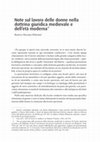
Iura Communia. Scritti in ricordo di Mario Montorzi, 2022
Tu quoque si operis tuis, mercede conventa, in re mea utaris, diceris locator operarum tuarum et ... more Tu quoque si operis tuis, mercede conventa, in re mea utaris, diceris locator operarum tuarum et ego earundem conductor» 1. Così Azone spiega chiaramente che il lavoro salariato è incluso nella grande categoria della locatio-conductio. Ad eccezione delle prestazioni legate allo status personale-quelle obbligatorie del servo e quelle 'volontarie' del libérto-qualsiasi prestazione lavorativa retribuita è concepita, dalla dottrina giuridica medievale, in termini di locatio operarum, un contratto di locazione, in cui, al posto di un bene immobile, si loca la propria opera in cambio di un prezzo 2. La prestazione lavorativa si configura come una locatio operis, nel caso di esecuzione di un manufatto o di uno specifico oggetto, anche della costruzione di un immobile, o come una locatio operarum, nel caso di lavoro per più giornate (ad esempio nei campi o in bottega). La tipologia della prestazione è oggetto di varie casistiche e di sottodistinzioni da parte dei giuristi, con particolare attenzione ai modi di risoluzione del contratto e alle fattispecie del dolo e dell'inadempienza. Nelle sedes materiae dedicate alla locatio-conductio non risulta una specifica attenzione al genere e non si fanno distinzioni in merito ad una presunta limitazione delle donne in relazione alla locatio operarum.
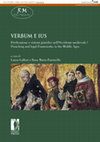
ITALIANO: Il Processus Satane e inserito con il titolo di Tractatus questionis ventilate coram do... more ITALIANO: Il Processus Satane e inserito con il titolo di Tractatus questionis ventilate coram domino nostro Iesu Christo inter virginem Mariam ex una parte et diabolum ex altera parte nel corpus dei trattati di Bartolo da Sassoferrato. Si tratta di un processo assai singolare, svoltosi in Paradiso, fra il Diavolo e la Vergine Maria che disputano sul possesso del genere umano, davanti a Cristo giudice. Destinato alle scuole di diritto e a quelle di teologia, il testo costituisce una efficace “messa in scena” di questioni strettamente giuridiche e di problematiche filosofiche: dalla rappresentanza processuale delle donne alle tematiche legate al possesso e allo spolium, dalla teoria della Salvezza al problema dell’esistenza stessa del male e del “diritto” del diavolo sull’umanita. / ENGLISH: With the title Tractatus questionis ventilate coram domino nostro Iesu Christo inter virginem Mariam ex una parte et diabolum ex altera parte, the Processus Satane is inserted into the corpus of ...
Il primo Parlamento: Siracusa 1398
De mandato aliorum et voluntate. Responsabilità e concorso nella dottrina di diritto comune: il Tractatus de maleficiis di Alberto Gandino

FRA DIRITTO E TEOLOGIA: L\u2019ARGOMENTAZIONE PROCESSUALE NELLA CULTURA MEDIEVALE
The tendency to apply procedural arguments to extra-legal situations is much more widespread than... more The tendency to apply procedural arguments to extra-legal situations is much more widespread than one might think. In the Middle Ages, this tendency incorporated different fields of knowledge in a much more casual and transversal way than is the case today. On the one hand, the entire construction of the Christian doctrine is characterized by the use of procedural metaphors (not only in the two events that mark the beginning and the end of humankind \u2013 the judgment against Adam in Eden and the Last Judgment \u2013 but also in biblical trials and the trial of Jesus). On the other hand, jurists\u2019 remarks about trials, which date back to the end of the 12th century, aim to construct an \u201cobjective\u201d system. Such an \u201cordo\u201d would guarantee, by means of in-depth analysis of various procedural steps, attainment of a \u201ctrue\u201d truth, i.e. the procedural truth, which is unique, cannot be replicated, and represents a truth as sacred as the liturgical on

El diablo en el Para\\uedso Derecho, teolog\\ueda y literatura en el Processus Satane (s. XIV)
El Diablo entra en el Para\\uedso, con la intenci\\uf3n de apropiarse de la humanidad utilizando ... more El Diablo entra en el Para\\uedso, con la intenci\\uf3n de apropiarse de la humanidad utilizando un nuevo y formidable instrumento: el proceso. Compuesto en el siglo XIV, transmitido como obra jur\\ueddica falsamente atribuida a Bartolo da Sassoferrato, el \\u201cProceso entre el Diablo y la Virgen Mar\\ueda\\u201d es un proceso simulado, en forma de di\\ue1logo, entre el Diablo, Cristo y la Virgen. Considerado como obra menor y casi ignorado por la historiograf\\ueda, la obra constituye en realidad un extraordinario ejemplo de sincretismo cultural: el lenguaje de la teolog\\ueda sirve al derecho como fuente de legitimaci\\uf3n, y a la inversa, la construcci\\uf3n escatol\\uf3gica y la misma teor\\ueda de la Salvaci\\uf3n se injertan en una estructura jur\\ueddica. Desde esta perspectiva, aqu\\ued se vuelve a proponer el texto como un punto de observaci\\uf3n ideal para aprehender las interacciones de una cultura poli\\ue9drica y compleja, suma de teatro y literatura, de derecho y teolog\\ueda, culta ...

La Lectura Peregrina di Andrea da Isernia e la costruzione editoriale degli apparati al Liber Augustalis
RIVISTA INTERNAZIONALE DI DIRITTO COMUNE, 2020
The history of the Liber Augustalis, from manuscripts to printed editions, make it possible to fo... more The history of the Liber Augustalis, from manuscripts to printed editions, make it possible to follow the path of adaptation of the glosses into two apparatuses, the Glossa Ordinaria by Marino da Caramanico and the Lectura Peregrina by Andrea da Isernia, which includes the notes of other jurists. Although moving in the wake of the literary genres of the school, this kind of interpretation is eminently practical. The aim is to create a link between the Liber Augustalis - still in force but often obsolete - and the law promulgated by Angevin sovereigns, fragmentary and unsystematic. For the legal science of the Regnum, the interpreter's task is to put together this different legal sources, creating a harmonious system and a 'set of rules', functional to practice
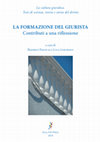
Il libro riproduce in parte gli interventi di un convegno dallo stesso titolo. Esso si propone co... more Il libro riproduce in parte gli interventi di un convegno dallo stesso titolo. Esso si propone come un momento di riflessione sul tema della formazione che gli attuali corsi universitari di giurisprudenza offrono ai futuri giuristi. Le recenti riforme sembrano non aver avvantaggiato gli studi giuridici. Anche il calo delle immatricolazioni pare aver colpito i corsi giuridici più di altri. Chi si occupa di formare i futuri professionisti del diritto (avvocati, magistrati etc.) deve anche preoccuparsi di preparare i giovani per quelle nuove professioni che una società in continua evoluzione viene proponendo e che richiedono anch'esse una formazione nelle materie giuridiche. Essi devono allora interrogarsi sulla perdurante attualità della loro offerta. Il metodo tradizionale è ancora quello che può dare i risultati migliori? I contenuti dei vari insegnamenti sono ancora adeguati? Si presta la necessaria attenzione al linguaggio utilizzato? È meglio accentuare ancora i profili profe...
Durantis, Speculum iudiciale
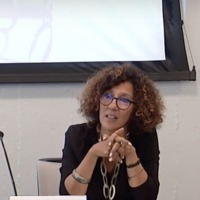



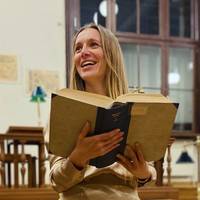
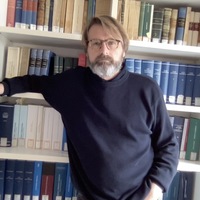

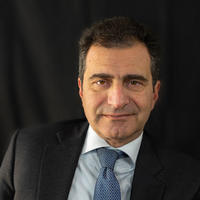



Uploads
Papers by Beatrice Pasciuta
My idea is that on the basis of these two female figures, both impossible models, legal doctrine, especially canon law, which is firmly based on theological doctrine but also on the sources of Roman law, builds a framework of possibilities and, above all, prohibitions that justify the reduced legal capacity of women as such and allow for conspicuous exceptions.
My idea is that on the basis of these two female figures, both impossible models, legal doctrine, especially canon law, which is firmly based on theological doctrine but also on the sources of Roman law, builds a framework of possibilities and, above all, prohibitions that justify the reduced legal capacity of women as such and allow for conspicuous exceptions.